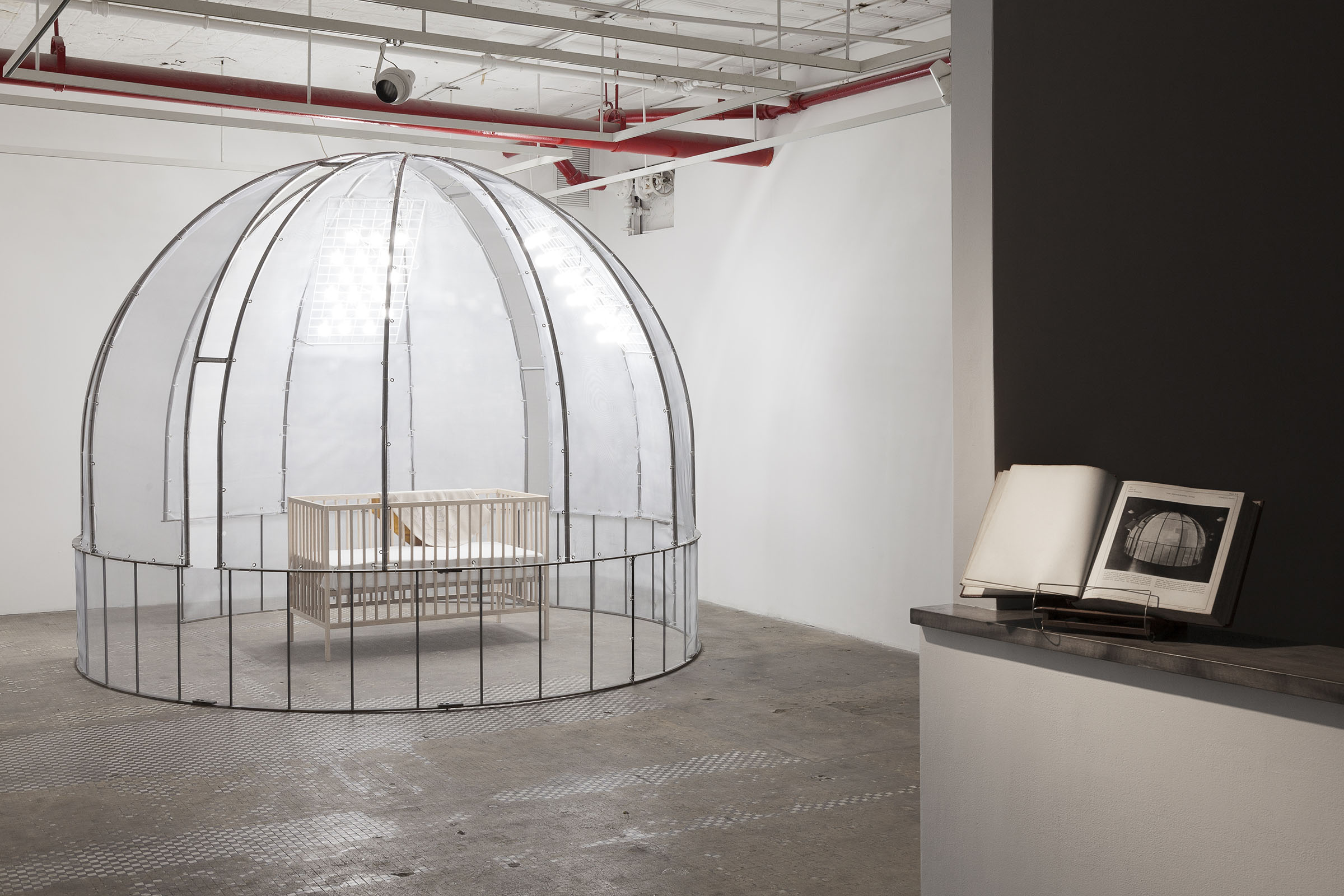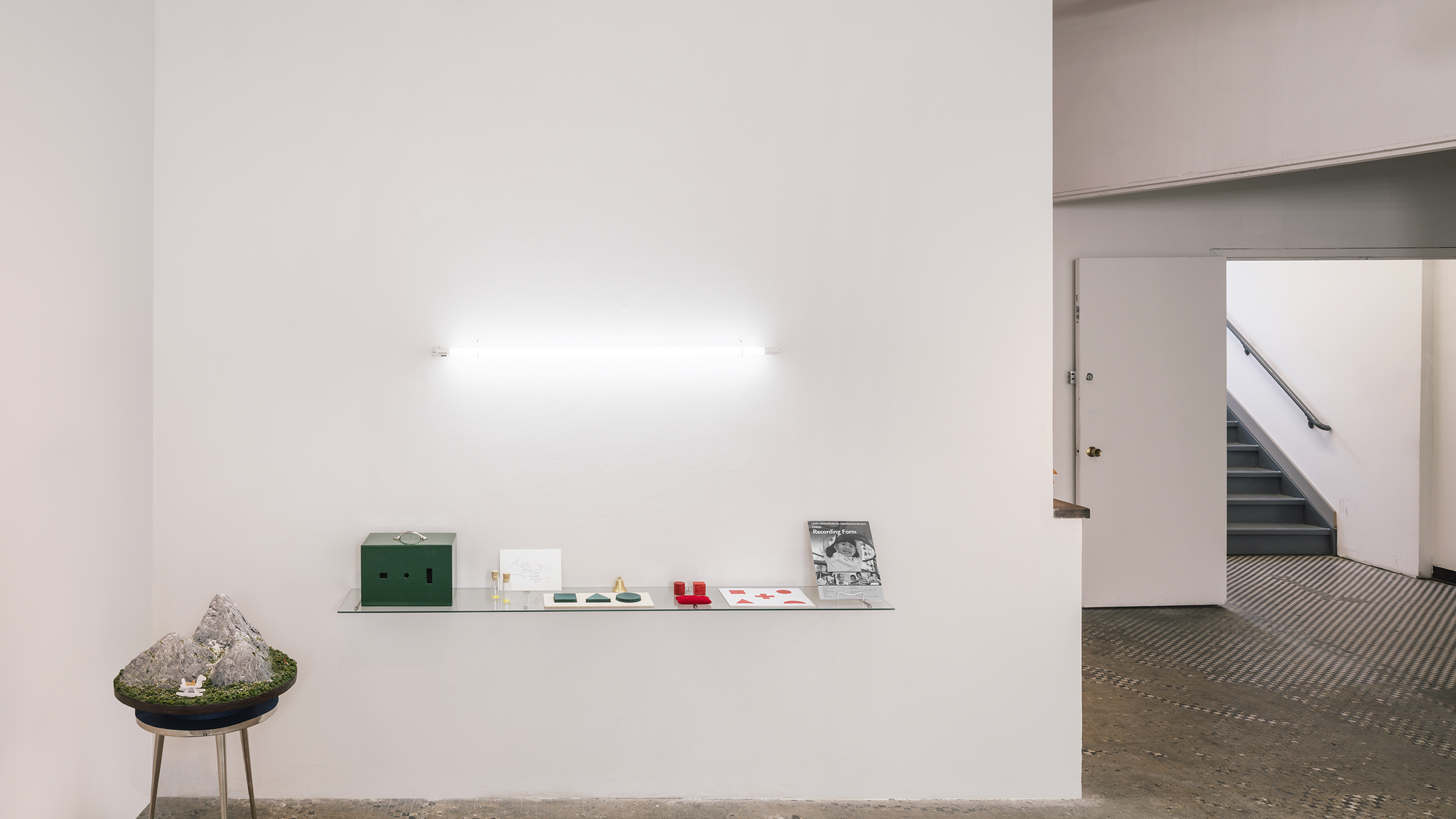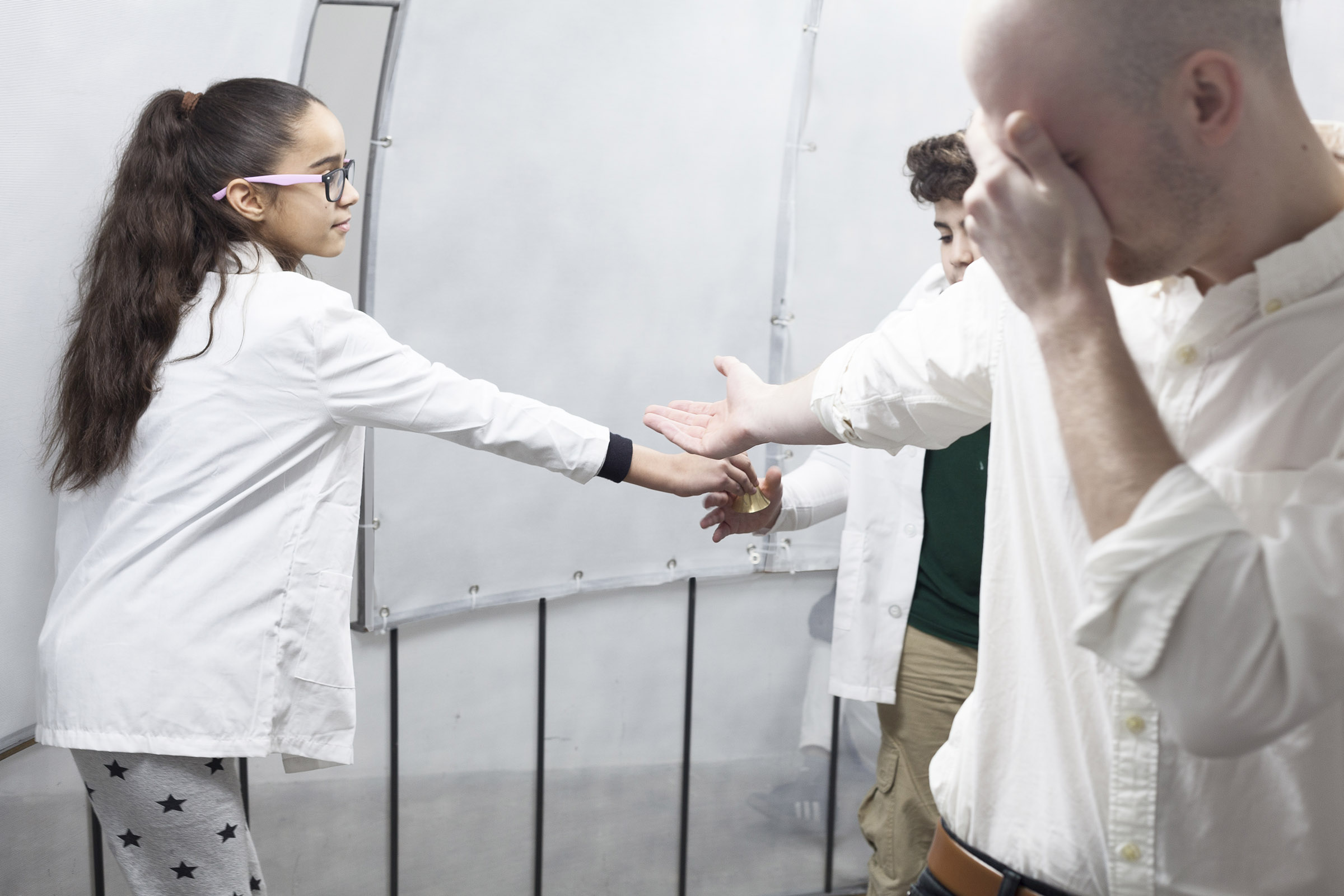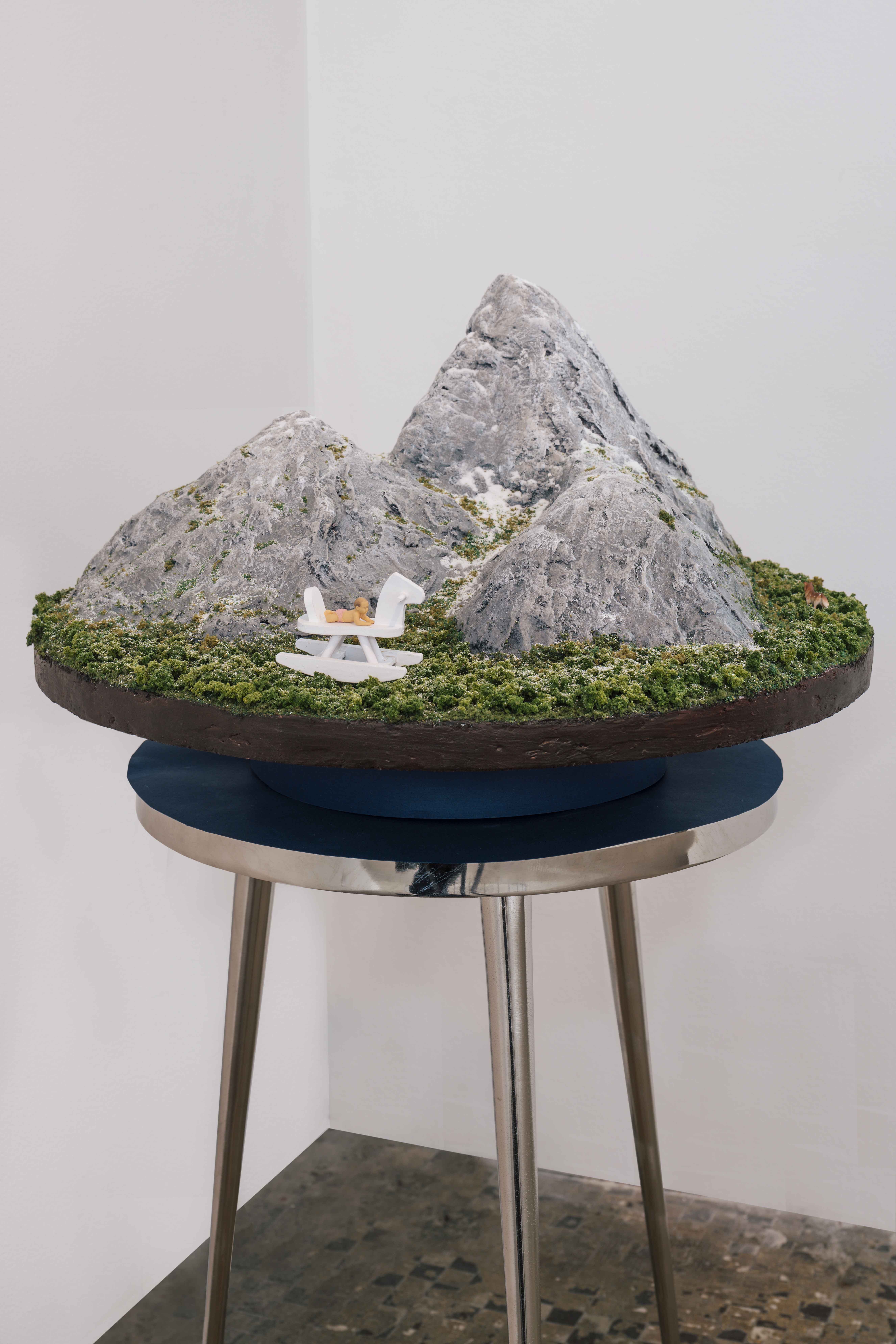How do art and science institutions inform the way we think and instruct us as subjects under contemporary neoliberalism? And how can those invested in the arts offer counter-hegemonic methods of knowledge production and new institutional frameworks? That is, how can we as artists and art audiences conceive of ourselves, after forty years of technocratic rule, as more than just isolated individuals, dissected, genetically determined, economically exploited, and communally anemic? The recent show Aesthetic Behavior; Developmental Sequences, a collaboration between architect, curator, and scholar Lluis Alexandre Casanovas Blanco and artist and educator Gabo Camnitzer, provides an opportunity to begin answering these questions. Installed from February 8 through March 10 of this year at NURTUREart in Brooklyn, it addressed a legacy of twentieth-century developmental psychology as well as contemporary trends in exhibition-making.
Before reaching the gallery desk at NURTUREart, visitors to the show find themselves in a shallow alcove at the bottom of the entryway stairs. Here soft electronic music is playing: Soothing Sounds for Baby—the 1964 album by Raymond Scott, developed in collaboration with the Gesell Institute. The minimal composition is inquisitive yet dreamy. From this vantage point both the reception desk and main gallery space are visible. The latter houses a domed structure while the former displays an open book with a historic photograph of the same structure printed inside. The structure is a reproduction of developmental psychologist Arnold Gesell’s observation dome, which he constructed in the early 1920s while leading a “child-research station” at Yale. It functioned as an apparatus to support and produce observational research. Gesell was a leader in the field as it was first emerging and played a large role in establishing its scientific reputation through his emphasis on biological development. He enjoyed both professional and popular success for the projects, processes, and publications generated under his direction at the Yale Clinic of Child Development. Today Gesell is best known for his “developmental norms”—a set of standards used to measure the behavior of children in order to determine the health and integrity of their nervous systems.

The photographic observation dome was the linchpin of Gesell’s work. Measuring 12 feet in diameter and height, the hemisphere was created by stretching a screen over a metal framework, onto which eight mercury vapor lamps were connected on the interior. The inside of the screen was painted white so that the light from the lamps bounced off it, creating one-way visibility from the outside in. Running along the arc of the dome was a track onto which two cameras could slide. Together with this vertical motion, the dome could also swivel horizontally atop its iron base—resulting in complete lateral and aerial visibility for the cameras. All of this allowed the child subject to be examined and recorded by both the analyst (inside the dome) and the students (outside) without distraction or any uncontrolled influence. This surveillance environment was critical to the experimental practice of Gesell, who theorized that a child’s nervous system determined their development, and that if measured through close and recordable observation, behavioral data could be applied retroactively to determine their health and progress. On the question of each child’s uniqueness within this theory, Esther Thelen and Karen E. Adolph conclude:
Infants are individuals from before birth, and their individuality manifests itself not only in characteristic pathways of physical growth but also in stable and enduring personality traits and in the maturation of mental styles and capabilities. Individual differences in behavior are as much a part of the organism as patterns of physical growth, and all are traits inherited both from the family and from the race as a whole. Although infants are plastic and learn from the culture, the limits of this plasticity are themselves genetically determined. Children’s constitutions determine “how, what, and to some extent even when” they will learn.1
This notion locates the origin of development in the unique individual—maintaining the singular organism’s authenticity in “characteristic pathways,” “enduring personality traits,” and “mental styles and capabilities.” Despite his conflicted view on the subject, Gesell would come to side with the geneticists on the genes vs. environment debate, advocating a biologically determinist theory of ontogeny (the development of the organism from fertilization to maturity). He is famous for stating that environmental factors ‘‘support, inflect, and specify, but they do not engender the basic forms and sequences of ontogeny.”2 The information developed from this position, using the dome and other tools, would form Gesell’s “developmental norms” and prove to be a substantive resource in the burgeoning fields of child study and developmental psychology.3 It is important to note that to qualify for examination within Gesell’s dome, and thereby set these standards, a child had to come from a white, middle-class, two-parent household of British or German descent living in New Haven.4 As such, Gessel’s study reflected, and in turn shaped, the racial and class biases of the day, coding the supposedly neutral scientific study with a hegemonic understanding of the human subject.
Inside Casanovas Blanco and Camnitzer’s dome we find a different scene of infant observation. In the center sits a generic Western crib with a hand-sewn blanket draped over its edge. Etched on one side of the blanket is an outline of a baby reaching out to a mirror image of itself, with a detached hand helping it sit up. Centered around this stitched image, the crib, and the surrounding dome, the rest of the exhibition’s components provide the many historic, performative, and theoretical nodes through which the audience can enter the hemisphere. The first of these nodes is in the form of a curatorial wall text. Rather than orienting viewers by providing an outline of the exhibition’s main themes, however, this wall label collates a series of press release excerpts describing recent exhibitions at prominent art institutions in New York:
Situated within an architecture of attention on a scale of theatrical proportions,[1] the subject is encircled by a silent audience. In this hermetic environment based on a radical reduction of optical and acoustic stimuli,[2] experiments from the history of psychology are deployed to record her physical and mental sensations.[3] The quantification of the subject’s unexpected, all-consuming encounters with the textures, forms, and functions of the living universe around her serve as a source of knowledge[4] and a way of contemplating timeless questions about the origins of human consciousness.[5]
[1] June 11–August 2, 2015
[2] March 24–August 2, 2017
[3] October 26, 2011–January 22, 2017
[4] October 26, 2016–January 15, 2017
[5] April 9–September 25, 2017
By composing a curatorial text vis-a-vis the descriptions of other art installations, Camnitzer and Casanovas Blanco frame Gesell’s observation dome within the art/audience dialectic—initiating a relation between the viewer in the installation and the infant under surveillance in the dome. This relation is reinforced by the mellifluous greeting at the show’s entrance, softly soothing those who come inside. The correlation between the sterilized dome and a white-washed gallery is perhaps an obvious one—both attempt to keep contamination from the outside world out through a series of phenomenological interventions such as blank walls, subdivided spaces, and strategic lighting. That the viewer might find herself becoming the subject of a contemporary art installation, however, requires a little more historicizing.
In the west, the theorization and historicization of minimalism would help substantiate the audience’s role in the production of art as elementary objects were meant to directly engage the spaces they were in as well as the bodies that would travel around them—effectively completing the trifecta of corporeal experience (object-space-body).5 Emphasis on the audience has continued through institutional critique and site-specificity to the more recent (re)ascensions of community art and social practice.6 Increased interest in the audience as a primary component of an artwork has required some traditional roles and duties within the field to change. As Miwon Kwon writes, “artists have adopted managerial functions of art institutions (curatorial, educational, archival) as an integral part of their creative process; managers of art within institutions (curators, educators, public program directors), who often take their cues from these artists, now function as authorial figures in their own right.”7 As these changes ebb and flow along with an increasingly aggressive private sector (the ruling class of which sit on more and more museum boards), we find tendencies within contemporary exhibition making to instrumentalize the audience.8 Kwon suggests that the increased lack of distinction between post–Cold War, globalizing cities prompts major art organizations to invite artists to develop projects in the communities surrounding them in order to generate “urban identity.” Effectively, they are teasing out an area’s idiosyncrasies and publicly displaying its unique characteristics to tourists and the gentrifying class.
Aesthetic Behavior uses installation and community engagement to situate developmental psychology in relation to participatory art practices. In the exhibition, the biopolitical meets the geopolitical: the former hardcoding the “unique” in the individual and the latter instrumentalizing said uniqueness for economic gain through audience-oriented projects. In this way, both Gesell’s developmental science of the early twentieth century and recent trends in participatory art position their subjects as the locus of authenticity in an economic order dependent on always re-creating the “new.”
In a recent essay, the psychologist and philosopher of science Susan Oyama offers a brief description of an alternative ontogeny using what she terms “Developmental Systems Theory” (DST):
Rather than starting with Biologos’s vision of discrete individuals whose basic properties exist (typically as genetic representations) without reference to their histories or surroundings, DST shows organisms in continuous, mutually transforming commerce with their environments, including other organisms. Defined as “pertaining to life,” furthermore, biology embraces the social as one of its aspects, not its contrast. Pertinent environments are defined (indeed, they arise as such) relative to the organism, and vice versa. Boundaries can be fluid and permeable: even our experienced bodily limits are quite inconstant, sometimes including phantom limbs and prosthetics, or the car whose perimeter we experience as our own. We construct the worlds in and from which we develop, by interacting, detecting some things but not others, being a given size and in a given place, being susceptible only to certain influences.9
In direct contrast to Gesell’s descriptions of infant individuality and his causal understanding of an individual’s growth, Oyama’s theory emphasizes becoming over being, in a form of critique inflected by the philosopher Gilles Deleuze. Formative for Deleuze was the work of another twentieth-century French philosopher, Gilbert Simondon. It is Simondon’s concept of transindividuation that can, along with Oyama’s particular focus on biology, offer a counter to the individual/collective relation maintained in theories such as Gesell’s. For Simondon, individuation is not the starting point or end goal of human development but rather the continuous process through which a pre-individual condition resolves its internal conflicts and tensions. Furthermore, Simondon argues that the senses and affects that constitute psychic individuation (character, personality, habit, etc.) do not cohere and so must attempt to resolve themselves through collective structures and relations. In this theory we find human development taking place not at either end of the rigid divide (individual vs. collective) but at their intersection. That we exist both collectively and individually, indeed that one constitutes the other (and vice versa), displaces the notion of an authentic individual forever attempting to “reach their full potential” while navigating an unresponsive world using ineffectual tools. Instead, what we have is the interplay between genes and environment, individual and collective.

Perpendicular to the gallery wall text and across from the dome is a shelf displaying a variety of printed images, objects, and reference material. The items are rudimentary in shape, design, and color. Their specific use is unclear from simply looking at them, but upon reading the show’s checklist (made available at the gallery desk), we find they are recreations of the objects and tools Gesell used to perform research on his child subjects. From the show’s press release, we learn of the sessions where these research tools will be put to use:
The props and instruments will be activated through a series of performative workshops with children from local schools. The children will be engaged in a dialogue about the history of child psychology and tasked with developing new modes of experimental research using the objects on an adult test subject. These workshops invert the power asymmetry permeating much of these studies by subjecting an adult’s experience to the disciplinary gaze of children.
Photo documentation of these events posted on social media show children outfitted with clipboards and lab coats, in groups of three or four at time, carrying out their procedures on an adult (not named) inside the dome. Important in this inversion of asymmetric power is how the interactive condition of development is not surgically removed but instead encouraged to direct the experiments as it (they) may—offering a rare form of radical pedagogy. The choice to collaborate, both between Camnitzer and Casanovas Blanco and between the artists and the children, situates collectivity as an organizing principle—allowing the group to address problems in developmental psychology through cooperation and shared experience. The loose criteria for participation (the only conditions being that you were a child and went to school nearby) further opens the tensions of experiments like Gesell’s, revealing the ethically and theoretically questionable practices used to produce standards of child development already informed by social markings of class, race, sexuality, and gender. Additionally, the role of technology in setting the limits and determining outcomes of research is highlighted by the choice to display the recreated tools as discrete art objects when not in use by the performers.10

Let us return again to the original question—toward and for what are we being oriented when experiencing one of the site-specific installations so commonly exhibited in today’s major museums? Historically, museums developed in tandem with the bourgeois public sphere as institutions that could reaffirm the status of their patrons by narrating their own history back to them. While locating one’s self within an audience-oriented art project then, we might ask ourselves: What history are we experiencing here? Is the hyper-rational, instrumentalizing force of global finance too easy an answer? Without any counter-conception of one’s relationship to the world of other organisms, objects, and environments, it might be the only answer available.
Aesthetic Behavior has been deinstalled, but the dream of biological determinism is elsewhere exhibited in both science and popular culture (think of HBO’s Westworld or Netflix’s Altered Carbon). If left unchecked, the normalizing effect of this ideology will further entrench experimental fields already embedded in the capitalist mode of production. Gesell’s own praise for the entrepreneurial spirit serves only to reinforce this claim:
THREE has a conforming mind. FOUR has a lively mind. THREE is assentive; FOUR, assertive. Indeed, FOUR tends to go out of bounds both with muscle and mind. And why should he not? If he remained a delightful, docile THREE, he would not grow up. So he surges ahead with bursts of movement and of imagination. His activity curve again takes on the hither and thither pattern typical of TWO YEARS. … If at times he seems somewhat voluble, dogmatic, boastful and bossy, it is because he is a blither amateur swinging into fresh fields of self expression.11
As this essay attempts to make clear, this kind of encouragement, particularly when institutionalized, is orienting: the addressed is set in competition, even domination, against a blank, historyless world.
Next to the shelf displaying the tools for research, there is a recreation of Jean Piaget and Bärbel Inhelder’s famous Three Mountain Problem. This is a static model made up of three mountains of varying height that are topped with different markers. Placed at the base of the mountains are a variety of small items, including animals, trees, and a dog bone. After being given time to look at and encounter the landscape from all angles, a child would be sat on one side of the model and asked what they saw in front of them. After listing the items they could see, the child would be asked what a doll or person, sitting on the other side of the model, might see from their side. Younger children would often recount what they could see from their side rather than that seen from the vantage point of the other person. The test was intended to locate at what age a child was no longer egocentric—one of Piaget’s four stages of cognitive development. The model at NURTUREart, however, is not static but continuously rotating atop a three-legged table. An initial read might conclude that there is no vantage point from which one could account for the perspective of another. My own feeling while watching the table turn, however, was that the perspective of the child and the perspective of the analyst were actually both my own—an individuation that requires the presence and perspectives of others in order to account for itself.

-
Esther Thelen and Karen E. Adolph, “Arnold L. Gesell: The paradox of nature and nurture,” Developmental Psychology, vol. 28, no. 3 (1992): 368–380. ↩
-
Arnold Gesell, “The Ontogenesis of Infant Behavior,” in Manual of Child Psychology, 2nd ed., ed. Leonard Carmichael (New York: Wiley, 1954), 354. ↩
-
With a decline in the number of children working in the labor force, the late nineteenth century saw a rise in orphanages, juvenile courts, reform schools, and mass education. ↩
-
Arnold Gesell and Helen Thompson, The Psychology of Early Growth Including Norms of Infant Behavior and a Method of Genetic Analysis (New York: Marchmillan, 1938). ↩
-
Hal Foster, The Return of the Real: The Avant-Garde at the End of the Century (Cambridge, MA: MIT Press, 1996), 35. ↩
-
For a primer on the “historic” and “neo” Avant-Gardes, see Benjamin Buchloh’s “Theorizing the Avant-Garde,” Art in America, November 1984, 19–21. ↩
-
Miwon Kwon, One Place After Another: Site-specific Art and Locational Identity (Cambridge, MA: MIT Press, 2002), 51. ↩
-
Andrea Fraser’s recent publication “2016 in Museums, Money, and Politics” traces the reported donations of trustees of 125 national art museums during the 2016 election cycle. ↩
-
Susan Oyama, “The Lure of Immateriality in Accounts of Development and Evolution,” in Mattering: Feminism, Science, and Materialism, ed. Victoria Pitts-Taylor (New York: New York University Press, 2016), 95. ↩
-
For an analysis of the film component of Gesell’s work, see: Scott Curtis, “Tangible as Tissue: Arnold Gesell, Infant Behavior, and Film Analysis,” Science in Context, vol. 24, no. 3 (2011): 417–442. ↩
-
Arnold Gesell and Frances Ilg, Infant and Child in the Culture of Today: The Guidance of Development in Home and Nursery (New York: Harper & Bros, 1943), 224. ↩
Filipe de Sousa is an artist, curator, and writer living in New York. His interdisciplinary practice is concerned with cultural production and its capacities for political and social change. His most recent projects have addressed growing up in the neoliberal epoch, data as labor, and the tourism industry in the far Northwest Americas.

